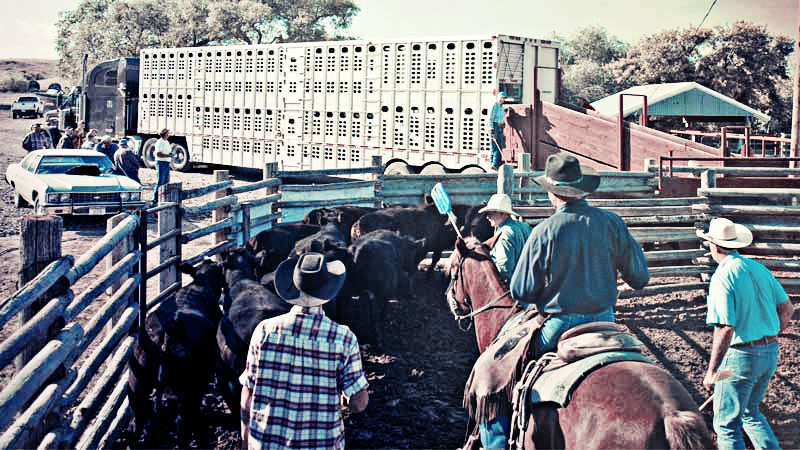
WORKER SAFETY CONSIDERATIONS ON THE RANCH AND WHILE HAULING CATTLE
Emma Mulvaney, Associate Director, Beef Quality Assurance Programs NCBA, a contractor to the Beef Checkoff | November 10, 2022
September is National Farm Health and Safety month and bringing awareness to the importance of human safety on any operation is critical because every day, about 100 agricultural workers suffer a lost-work-time injury1. In 2019, 410 farmers and farm workers died from a work-related injury, resulting in a fatality rate of 19.4 deaths per 100,000 workers1. While many efforts for improving safety and health on farms and ranches are focused on the cattle, recognizing the importance of keeping those who work with cattle safe and healthy is just as crucial.When working with large animals and large pieces of equipment, there is always the opportunity for potential harm. The Beef Checkoff-funded Beef Quality Assurance (BQA) program has many tools to train employees and improve human and animal safety. Understanding the animals as well as the best handling practices and how to use equipment properly are steps to keeping those handling cattle safe. Below is a list you should consider doing and things you consider avoiding when it comes to handling or hauling cattle.
Do’s
- Renew your BQA certification every three years to stay up to date with the most recent worker safety information2
- Always consider human safety first when handling cattle2
- Wear personal protective equipment such as close-toed boots, masks, goggles, gloves, or others when you are around poorly ventilated areas, using pesticides, for biosecurity purposes, and for general safety around large animals2
- Read the label on any animal health product you are administering and know how to properly dispose of needles and animal health product containers2
- Develop an Emergency Action Plan for your operation and have multiple copies in your office and where employees are frequently working2
- Effectively communicate between all individuals while handling cattle. Doing so reduces the risk of injury for both humans and cattle2
- Apply basic sanitation practices to equipment, vehicles, and clothing to decrease the chance of microbial contamination2
- Use maintained vehicles and trailers to transport cattle that provide for the safety of personnel and cattle during loading, transporting, and unloading3
- Before transporting cattle, check the weather and route to ensure a safe and uneventful trip3
Do Not’s
- Risk human safety for the safety of cattle2
- Leave exposed animal health products on your farm or ranch. Always store them in a designated area that meets product label storage requirements like a refrigerator or climate-controlled closet that minimizes light2
- Move cattle through facilities that are not conducive to human safety2
- Euthanize an animal with a firearm unless you are trained and understand how and where to properly utilize this tool to carry out euthanasia2
- Open an overturned cattle trailer and always ensure the safety of humans first3
- Operate heavy equipment unless you are trained and expected to use the equipment2
- Haul cattle if you are fatigued3
- Stand in between a gate panel and swinging gate and always yourself adequate room to exit the space to avoid becoming trapped2
In addition, we must consider the younger farm hands, children, and grandchildren that help with raising cattle. Youth family members that help on a cattle operation should consider going through the Think F.A.S.T. program offered by American Farm Bureau Federation. The free program is tailored to a 14–17-year-old audience and focuses on general safety, leadership, and critical thinking skills. There are 10 modules, and each takes 10 minutes to complete. This program is offered online and there are downloadable in person training materials for educators4.
A healthy operation cannot continue to do business without healthy farmers and ranchers. Mental health is directly related to physical health and remembering to take care of your mind while you take care of your body. In the need of immediate and effective support services for farm families experiencing crisis, please call 1-800-FARM-AID5.
For additional resources for handling cattle safely during hauling, encourage your local law enforcement to go through the Bovine Emergency Response Program (BERP). “The Bovine Emergency Response Program is about training first responders on how to handle Livestock in an emergency,” says Steve Boyles, BERP Trainer & Ohio BQA State Coordinator. To improve stockmanship on your farm, consider attending a Stockmanship and Stewardship event in your area.
To learn more visit STOCKMANSHIPANDSTEWARDSHIP.ORG.
To learn more about worker safety on cattle operations and during cattle hauling, visit BQA.ORG.
Sources:
1 Center for Disease Control. Agricultural Safety. https://www.cdc.gov/niosh/topics/aginjury/. (Accessed August 15, 2022).
2 Beef Quality Assurance. Manual Resources, BQA National Manual. https://www.bqa.org/resources/manuals. (Accessed August 15th, 2022).
3 Beef Quality Assurance. Manual Resources, BQA Transportation National Manual. https://www.bqa.org/resources/manuals. (Accessed August 15th, 2022).
4 American Farm Bureau Federation. Think F.A.S.T. https://www.fb.org/programs/safety-health/thinkfast/. (Accessed August 15, 2022).
5 Farm Aid. Our Work. https://www.farmaid.org/our-work/. (Accessed August 15, 2022).
This article was originally published in the September 2022 issue of NCBA National Cattlemen newsletter.
Share This Page